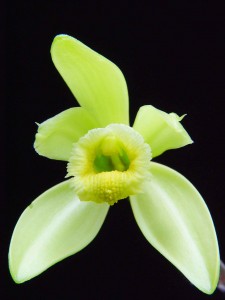Flavors to Savor in the Boettcher Memorial Tropical Conservatory
When it is as hot outside (and inside the Boettcher Memorial Tropical Conservatory), as it has been, I tend to find myself eating more ice cream. Last night as I was enjoying a mixed bowl of chocolate and vanilla ice cream, it made me think about two of my favorite plants in the Boettcher Tropical Conservatory: Theobroma cacao, or chocolate, and Vanilla planifolia or, you guessed it, vanilla.  Theobroma cacao is native to tropical Central and South America, and is a strong representative of the Sterculiaceae family, although it was formerly placed in Malvaceae (the Hibiscus Family) until recently. Chocolate has been a very important crop world wide for a very long time. In fact, it was so important to the natives who first started cultivating it, that they called it the "food of the gods." Nowadays, the Latin botanical name of the genus, Theobroma, translates to "Food of the Gods." The tree is often of smaller size, around 15 to 26 feet high, and is evergreen. One of my favorite characteristics of Theobroma is its cauliflorous flowering and fruiting habit. This means that the flowers and later the fruit grow directly from the stem and branches of the tree. As we all know, the fruit is edible, although it hardly tastes like biting into a Hershey bar, and the texture is somewhat mucilaginous. The leaves are toxic and should not be consumed. Our beautiful chocolate tree may be found along the south wall of the Boettcher Tropical Conservatory right as you start walking up the path. Vanilla planifolia is quite the interesting plant. It hails from the Orchidaceae family. Yes that's right, vanilla comes from an orchid. Vanilla planifolia is native to Mexico and is grown throughout the world, but most of the commercially available vanilla and extracts are from Mexico and Madagascar.
Theobroma cacao is native to tropical Central and South America, and is a strong representative of the Sterculiaceae family, although it was formerly placed in Malvaceae (the Hibiscus Family) until recently. Chocolate has been a very important crop world wide for a very long time. In fact, it was so important to the natives who first started cultivating it, that they called it the "food of the gods." Nowadays, the Latin botanical name of the genus, Theobroma, translates to "Food of the Gods." The tree is often of smaller size, around 15 to 26 feet high, and is evergreen. One of my favorite characteristics of Theobroma is its cauliflorous flowering and fruiting habit. This means that the flowers and later the fruit grow directly from the stem and branches of the tree. As we all know, the fruit is edible, although it hardly tastes like biting into a Hershey bar, and the texture is somewhat mucilaginous. The leaves are toxic and should not be consumed. Our beautiful chocolate tree may be found along the south wall of the Boettcher Tropical Conservatory right as you start walking up the path. Vanilla planifolia is quite the interesting plant. It hails from the Orchidaceae family. Yes that's right, vanilla comes from an orchid. Vanilla planifolia is native to Mexico and is grown throughout the world, but most of the commercially available vanilla and extracts are from Mexico and Madagascar.  V. planifolia is often times called, "The Vanilla", because of all of the members of the genus Vanilla, it is the one most commonly used for food. All members of the genus Vanilla are vines, this is something that sets the plant apart from most of the orchid family. Vanilla fruits only at a certain maturity, this is typically achieved once the plant reaches approximately ten feet long. In cultivation, the flowers are almost exclusively hand pollinated to ensure a good fruit set. The fruits can reach up to almost one foot long and are pods. Calling a vanilla pod a bean, is incorrect. The fruits take about six months to ripen before they can be picked. Vanilla is a very labor intensive crop and takes seemingly forever, so this accounts for high grocery store prices. Our specimen is located just before the chocolate tree and is growing up the glass looking into the Offshoots at the Gardens bistro. Hopefully we see you soon, stay cool, and next time you enjoy some chocolate or vanilla ice cream, think about the plants from which these flavors are born. Cheers!
V. planifolia is often times called, "The Vanilla", because of all of the members of the genus Vanilla, it is the one most commonly used for food. All members of the genus Vanilla are vines, this is something that sets the plant apart from most of the orchid family. Vanilla fruits only at a certain maturity, this is typically achieved once the plant reaches approximately ten feet long. In cultivation, the flowers are almost exclusively hand pollinated to ensure a good fruit set. The fruits can reach up to almost one foot long and are pods. Calling a vanilla pod a bean, is incorrect. The fruits take about six months to ripen before they can be picked. Vanilla is a very labor intensive crop and takes seemingly forever, so this accounts for high grocery store prices. Our specimen is located just before the chocolate tree and is growing up the glass looking into the Offshoots at the Gardens bistro. Hopefully we see you soon, stay cool, and next time you enjoy some chocolate or vanilla ice cream, think about the plants from which these flavors are born. Cheers!
Add new comment